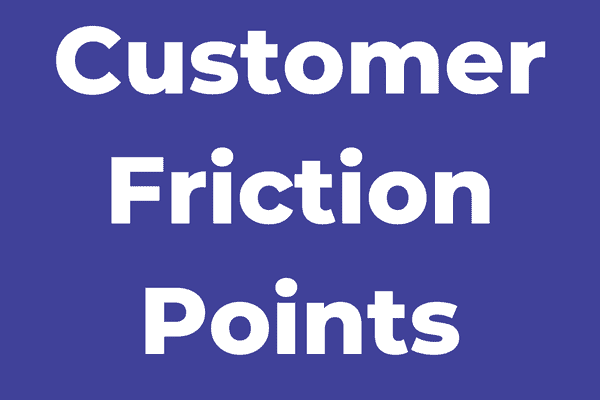For customers, making a phone call is the simplest and quickest way to obtain information or a resolution to a problem. However, from a customer service point of view, the phone call might be inconvenient.
If the telephone is the initial point of contact for the client, it might create a set of customer friction points. That is why the pick-up rate and average waiting time remain the two most visible areas for improvement within the call center industry.
In this article, we will identify the key sources of friction during a customer care interaction and share a couple of solutions on how to solve them.
What are Customer Friction Points?
The customer journey is unique to each individual and provides an overview of all the contacts between a client and a company. However, certain repeating events can irritate clients and foster an awful experience.
These are all the instances that negatively influence the company’s reputation or lead to transaction abandonment. They are commonly referred to as “friction points”. Identifying the exact instance of friction is a method for improving the customer experience throughout the customer journey.
Why bother with these friction points?
Frustration and engagement are necessary to get the customer to move along the journey.
Frustration means the customer needs help. Engagement means customers have found a product or service they want to purchase.
Conversely, customers who are satisfied with their experience won’t hesitate to engage with you.
What are the types of customer friction?
Customer support is unreachable or unavailable
Nothing is more aggravating than contacting a customer service number and not getting a response. There are terrible instances when no agent answers the phone, interminable music, or the infamous automated message that continues saying all agents are on the line and request to call back later.
This is why employing an IVR to achieve a virtual 100% pick-up rate is critical. The IVR, often known as a virtual switchboard, allows you to manage all concurrent calls and queues.
 Long waiting times
Long waiting timesCustomers are no longer willing to wait. As a result, the most critical dissatisfaction cause remains the time it takes to talk to an agent and receive the appropriate answer.
To avoid long wait times, you need to identify clients and qualify the request as soon as you receive the call. An IVR can identify a consumer based on their phone number, and the call may be directed to the most qualified agent based on the case status, language, or geolocation.
Requests are being routed incorrectly
Too often, when the agent finally answers the phone, they cannot fulfill the request and must transfer the call to another contact person.
Apart from adding to the wait time, this call transfer frequently fails to follow up on prior conversations. As a result, the client must repeat his request to each agent. All of these problems will most definitely add up to a bad experience. This is why it is critical to have excellent call routing capabilities.
What types of customer interactions are associated with friction points?
-
Immediate Customer Needs vs. Frustration
Many people call a company and say: “I am calling about a purchase”. This is generally an instant feedback point. If you aren’t the right contact, it doesn’t mean the deal will close.
-
Technological Issues
The technology isn’t cutting it. You will most definitely drive customers away if you’re short on staff and cannot compensate for this with a decent technological setup.
-
Price
A customer buys a product and asks: “How much does it cost?”
-
Formalities
The situation is problematic if you can’t get on the line or send an email. Customers are not a well-trained bunch.
-
Customer Service Experience
The company doesn’t care about the customer experience. The messages are lost in a vast void. Once the customer reaches a low point, they are gone, and the background is a “walk of shame.”
Not offering callbacks during friction
Waiting is sometimes inevitable due to busy periods or limited personnel. To minimize the subsequent unhappiness, announce the expected wait time and the times of day when your agents are more available.
Finally, using the automated callback settings, suggest to your consumer that an agent contact them at a particular time.
The connection is the most critical factor in customer interactions. This connection must be established quickly and efficiently with the appropriate counselor, with no unnecessary waiting time. Intelligent IVR, agile approach… Several solutions and methods are available to eliminate friction points during client contact.
How to identify the friction points?
The customer journey planner needs to categorize all customer contact data to get a realistic overview of the possible touchpoints. It should create a map of all the friction points with a particular color and icons.
Risks associated with such a map:
- It is challenging to discover all the friction points and where they are. All the customer data is scattered around, making it difficult to find trends and separate the issues.
- Any resistance to change or the perception within the company that the process is too complex would lead to confusion. The customer will feel like you are stonewalling them. You will create an expectation gap which is a hazardous situation.
- You might become so focused on your strategy that you forget to build a connection with your customers.
The opposite is also true: It could become so overwhelming that you forget to focus on the real problems and possible solutions. You’ll become overwhelmed with data and assumptions. You’ll no longer have time to find out what’s wrong and how to fix it.
Identify all the channels used by customers
To begin, you need to understand the various points of contact and connection with your clients, which are becoming increasingly numerous. A client can contact a firm via an online chatbot, email, social media, or a physical exchange with a salesperson.
To understand them, consider creating a map that includes each interaction point and how it fits into the customer journey.
Put yourself in your customers’ shoes
The next step is to put yourself in your consumers’ shoes. You will be able to recognize the factors that may obstruct a smooth buying path and calculate the winning patterns. To do this, don’t be afraid to make important purchases or take critical activities on your own by following the previously outlined paths. You may come across unexpected friction points.
Rely on data and metrics
To fully understand and identify your friction points, whether it’s for a point of sale, a customer service issue, or any other type of business, you must also rely on concrete statistical elements: your attrition rate, abandoned calls or purchases, and other outbound or inbound call center key performance indicators (kpis).
These numbers will help you identify the bottlenecks and devise tailored tactics to improve the client experience.
Use satisfaction surveys
The final option is to deploy satisfaction surveys. They are crucial for understanding the perspectives of your prospects and customers when distributed through the communication channel that looks most relevant to you. Were they happy with their journey? What didn’t they like? Which criteria earned the lowest level of satisfaction? Why would they not suggest your business to their friends and family?
How to remove customer friction points?
Mastering omnichannel in a call center
You must grasp the omnichannel nature of your interaction points to establish frictionless journeys.
The use and mobilization of all potential communication and sales channels between the firm and its clients are referred to as omnichannel.
For example, giving a customer the option to purchase goods at both a physical and a digital point of sale (computer, tablet, smartphone…).
Customers must have access to the same services regardless of the point of contact they choose to be linked with for omnichannel to be completely mastered.
If omnichannel is not mastered, if the consumer experience is not as smooth and comprehensive across channels, friction will emerge. When confronted with these frictions, the buyer risks disrupting the purchase process.
With our cloud contact center software OMNI+, you have a personalized Reports Engine at your disposal that allows you to harness the power of data. Get reliable data from various analytics and reporting solutions that give historical and real-time data that you can tweak to create complete performance reports.
The essentials for a controlled omnichannel experience
- The pricing or products/services listed on the various channels are the same.
- The consumer is identified regardless of the contact channel which they choose to use
- The history of customer interactions is retained and available regardless of the channel used
- The client may pick the delivery or purchase channel
If having no customer friction implies customer journey uniformity, it also means a speeding up of the latter.
Indeed, the more complicated the customer experience, the more probable the consumer will quit along the way. Frictionless needs uncomplicated client interactions with a limited number of steps and clicks.
You can also seamlessly manage all communication channels: Voice Calls, Facebook Messenger, Twitter, WhatsApp, Telegram, SMS, Email, Live Chat, Webchat, and Voicemail.
Setting up a smart IVR
For your clients, an IVR solution must be synonymous with fluidity. However, when confronted with a poorly designed IVR, presenting infinite options, or failing to consider all circumstances, the consumer is frequently lost.
As a result, while building any IVR, it is critical to present a basic tree structure in which each option is available in no more than three possibilities. Furthermore, an effective IVR may provide a variety of basic or repeated replies without the need for human involvement. This minimizes the workload of your agents, who gain efficiency as a result.
Step-by-step Solution
It’s essential to keep the goal in mind and concentrate on the most critical moments for the customers.
From the first contact to the last:
- Connect!
Make sure there is a high level of connection between you and your customers. Make it fun and engaging.
- Consistency.
If something has gone wrong or not as expected, let the customer know you take responsibility and would like to make it right. They’ll appreciate it.
- Answer questions.
A lot of the time, customers have questions and need answers. The way to answer them is by using a friendly, engaging, and supportive dialogue.
- Embrace their feedback.
The customer experience is an incredible opportunity to learn. When the customer is happy, it’s also an opportunity to improve. They want you to get better.
All customer interactions should be seen as an opportunity for growth. When you build connections with your customers, you’ll know how to identify what works and needs improvement.
You’ll be able to make changes to improve the experience.
Conclusion
To stand out from the competition, call centers must focus on the customer experience of their users and clients. Adopting solutions such as Omnichannel and Smart IVRs will optimize your customer experience and remove all frictions. Indeed, it is about streamlining the development process of a project by putting the consumer at the center of all contact center offers.
At NobelBiz, our Interactive Voice Response (IVR) has been renamed and redesigned to accommodate the whole omnichannel experience. This entails transitioning from a one-interaction IVR to a multi-interaction DBR.
Our new and upgraded Dynamic Business Router (DBR) can now identify incoming channels through phone, WhatsApp, email, Twitter, Telegram, and more.

Abdelmounim Benharouga has always had a strong passion for writing and digital marketing. He started as a Digital Content Writer part of marketing department then moved to being Customer Success Manager for the African Region within the Nobelbiz team.







